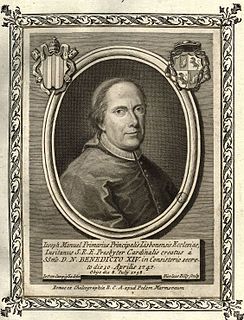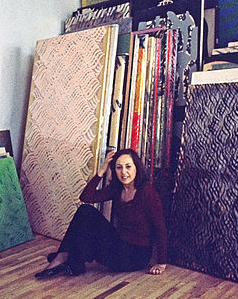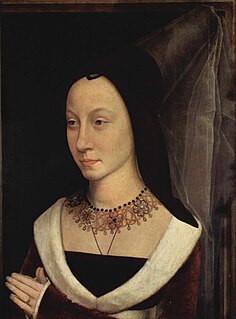
Domenico di Tommaso Curradi di Doffo Bigordi, professionally known as Domenico Ghirlandaio, also spelled as Ghirlandajo, was an Italian Renaissance painter born in Florence. Ghirlandaio was part of the so-called "third generation" of the Florentine Renaissance, along with Verrocchio, the Pollaiolo brothers and Sandro Botticelli. Ghirlandaio led a large and efficient workshop that included his brothers Davide Ghirlandaio and Benedetto Ghirlandaio, his brother-in-law Bastiano Mainardi from San Gimignano, and later his son Ridolfo Ghirlandaio. Many apprentices passed through Ghirlandaio's workshop, including the famous Michelangelo. Ghirlandaio's particular talent lay in his ability to posit depictions of contemporary life and portraits of contemporary people within the context of religious narratives, bringing him great popularity and many large commissions.

Renaissance art is the painting, sculpture, and decorative arts of the period of European history known as the Renaissance, which emerged as a distinct style in Italy in about AD 1400, in parallel with developments which occurred in philosophy, literature, music, science, and technology. Renaissance art took as its foundation the art of Classical antiquity, perceived as the noblest of ancient traditions, but transformed that tradition by absorbing recent developments in the art of Northern Europe and by applying contemporary scientific knowledge. Along with Renaissance humanist philosophy, it spread throughout Europe, affecting both artists and their patrons with the development of new techniques and new artistic sensibilities. For art historians, Renaissance art marks the transition of Europe from the medieval period to the Early Modern age.

Pietro Perugino, born Pietro Vannucci, was an Italian Renaissance painter of the Umbrian school, who developed some of the qualities that found classic expression in the High Renaissance. Raphael was his most famous pupil.

Francesco Francia, whose real name was Francesco Raibolini was an Italian painter, goldsmith, and medallist from Bologna, who was also director of the city mint.

Francesco d'Ubertino Verdi, called Bachiacca. He is also known as Francesco Ubertini, il Bacchiacca (1494–1557). He was an Italian painter of the Renaissance whose work is characteristic of the Florentine Mannerist style.

Giovanni Domenico Campiglia (1692–1768) was an Italian painter and engraver from Florence, active under the patronage of the House of Medici.
The decade of the 1490s in art involved some significant events.
The decade of the 1480s in art involved some significant events.
The decade of the 1470s in art involved some significant events.
The decade of the 1430s in art involved some significant events.

The Portrait of Perugino is a portrait of the Italian Renaissance artist Perugino attributed to his pupil Raphael or to Lorenzo di Credi. It was produced around 1504 and is now in the Uffizi gallery, Florence.

Andrea del Sarto was an Italian painter from Florence, whose career flourished during the High Renaissance and early Mannerism. He was known as an outstanding fresco decorator, painter of altar-pieces, portraitist, draughtsman, and colorist. Though highly regarded during his lifetime as an artist senza errori, his renown was eclipsed after his death by that of his contemporaries Leonardo da Vinci, Michelangelo, and Raphael.

The Portrait of a Man with a Roman Medal is a painting by the German-born Flemish artist Hans Memling, dating to c. 1480 and housed in the Royal Museum of Fine Arts, Antwerp, Belgium.

Carla Accardi was an Italian abstract painter associated with the Arte Informel and Arte Povera movements, and a founding member of the Italian art groups Forma (1947) and Continuità (1961).

The Baptism of Christ is a fresco by the Italian Renaissance painter Pietro Perugino and his workshop, executed around 1482 and located in the Sistine Chapel, Rome.

The Portrait of Lorenzo di Credi is a painting by the Italian Renaissance artist Perugino, dating to around 1504 and housed in the National Gallery of Art, Washington, DC, United States.

The Lamentation of Christ is an oil-on-panel painting of the common subject of the Lamentation of Christ by the Netherlandish artist Rogier van der Weyden, dating from around 1460–1463 and now in the Uffizi Gallery, Florence, Italy.

Portrait of Maria Portinari is a small c. 1470–72 painting by Hans Memling in tempera and oil on oak panel. It portrays Maria Maddalena Baroncelli, about whom very little is known. She is about 14 years old, and depicted shortly before her wedding to the Italian banker Tommaso Portinari. Maria is dressed in the height of late fifteenth-century fashion, with a long black hennin with a transparent veil and an elaborate jewel-studded necklace. Her headdress is similar and necklace identical to those in her depiction in Hugo van der Goes's later Portinari Altarpiece, a painting that may have been partly based on Memling's portrait.

Portrait of Tommaso Portinari by Hans Memling is held by the Metropolitan Museum of Art, New York City. It was made c.1470 in oil on oak panel, and measures 44.1 by 33.7 centimetres. The painting and Memling's Portrait of Maria Portinari form the wings from a since dismantled triptych; the central panel is believed to have been a now lost depiction of the Madonna and Child; perhaps Memling's Virgin and Child in the National Gallery, London.















